Somehow I’ve made it through half my life without knowing bird songs, classical music, or trees. It’s stunning to ponder how much I’ve missed over the years whenever I heard birds and left it at the simple thought, “Oh. Birds.” Same goes for my typical reaction to the magnum opus of any given legendary composer: “Huh, classical music.” Did I just drive by the last stand of old growth forest in the county? “Cool trees.”
Luckily I work with children’s books at the library, and this summer, as we’re trying to unplug and get back to appreciating all the wonders of the real world, I’ve found a great guide for each of these three areas. My kids enjoyed them, too, but each of these books made its way back into my hands for closer reading after the kids were asleep. Annette LeBlanc Cate’s Look Up! Bird-Watching in Your Own Backyard is one of the most charmingly informative books I’ve seen about any subject lately, and Robert Levine and Meredith Hamilton’s The Story of the Orchestra (complete with a CD of musical samples) gave me the music appreciation crash course I always needed. As for trees, The Tree Book for Kids and Their Grown-Ups, written by Gina Ingoglia and published by the Brooklyn Botanic Garden, is a recently acquired must-have for the library.
THE TREE BOOK FOR KIDS AND THEIR GROWN-UPS
I’m particularly excited about that last, because so many of the wisest people I’ve known are the same ones who can identify trees. And it’s not that I ignore trees; in fact I have a small “collection” of interesting trees I’ve kept in my head for years. You know those biological landmarks we pass every day as we go about our business—a strange trunk bending over a fence, a shade tree near a playground our kids frequent.
In the interest of looking closer and learning a little something this summer, I’ve enlisted one of those wise friends, fellow LPL-er Jake Vail, a former arborist and the co-author of A Kansas Bestiary, to take a look at some of my favorite trees around town, help us identify them, and take a shot at figuring out why they look like they do. I bet you will recognize them, too.
Tree #1
Location: Just north of Holcom Rec Center
Dan: I often see kids (including my own) playing in, on, and around this majestic tree, located right next to the playground at Holcom. It has the most amazing horizontal branches, just high enough to give young climbers a little adrenalin rush. If it likes kids, it must be the happiest tree in Lawrence. But it looks like it has about 10 trunks. Is this one tree, or many? How does this happen?
Jake:
This is an Osage orange, a great Kansas tree, which can grow pretty massive for these parts. Also known as hedge, they have separate male and female trees, and the females shed the famous large warty compound fruits often called hedge apples or hedge balls in the fall. The wood lasts practically forever and is therefore favored for fence posts, and it burns really hot as well.
Is this one tree or many? Richard Powers, author of The Overstory, might say there is no such thing as one tree. (And notice the different-looking trunk, fairly vertical on the left -- a sneaky hackberry.) My guess is that this a group of siblings, all germinated from a hedge ball-laden pile of raccoon scat.
Tree #2
Location: Northeast corner of 16th and Kentucky Streets
Dan: I've passed this tree leaning out over a fence for years as I drive north on Kentucky, or walk past on the sidewalk.

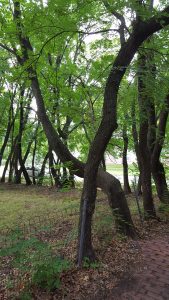
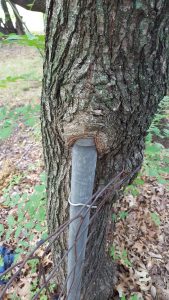 Jake: Tricky picture, but the leaves make it obvious: Golden rain tree, Koelrueteria paniculata. Not a Kansas native. (The mulberry sprouts by the tree on the left had me fooled for a second.) The nice row makes me think they were planted, but the fence makes me wonder if the seeds were dropped by perched birds or squirrels. Or a short-sighted gardener. I've seen these particular trees as well, and wondered about them - and why does that one tree have that odd curve, but not the others?
Jake: Tricky picture, but the leaves make it obvious: Golden rain tree, Koelrueteria paniculata. Not a Kansas native. (The mulberry sprouts by the tree on the left had me fooled for a second.) The nice row makes me think they were planted, but the fence makes me wonder if the seeds were dropped by perched birds or squirrels. Or a short-sighted gardener. I've seen these particular trees as well, and wondered about them - and why does that one tree have that odd curve, but not the others?
Dan: That last photo begs the question: Do trees feel pain?
Jake: Do metal posts feel stifled? The post didn't jab up into the tree's bark; the post and fence were here first, and the tree is growing over/around them. Who will win? Not the guy wielding the chainsaw (voice of experience). To answer your question, yes. Read Peter Wohlleben's The Hidden Life of Trees for more.
Tree #3
Location: Just north of the gazebo in South Park.
Dan: This tree was a mystery to me until I discovered a small sign indicating it is a lacebark elm (visible in the first photo). I don't really have a specific question or comment about it, just pure admiration.


Jake: Nice find. Also called Chinese elm, considered one of the finest elms. Not to be confused with the Siberian elm, which is more common around here, in windbreaks and farmsteads and western Kansas towns, and is NOT a fine elm.
A favorite question to stump (ha!) the layperson: if the sign is eight feet up and the tree grows twelve inches a year, how high will the sign be in ten years?
Eight feet.
Dan: It took me a half hour to figure that out. Must be why I'm a librarian and not an arborist.
Tree #4
Location: Embankment off the south shoulder of Kansas Highway 10, eastbound, just west of Olathe
Dan: I love this little horizontal tree I always look for on my way to Kansas City. I keep saying I am going to decorate it for Christmas someday. But what is it thinking?
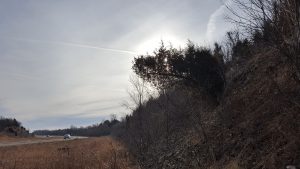
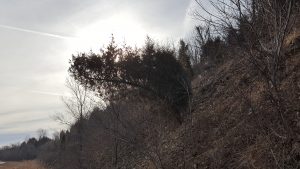
Jake: Eastern red cedar, which is a juniper. Don't get me started on trees called cedars. The only native Kansas conifer(!) (whose cones we call berries). Birds eat the berries and spread them far and wide, and without the fires with which the prairie evolved cedar trees become very invasive. I can't figure out this one's peculiar growth habit.
Tree #5
Location: My front yard
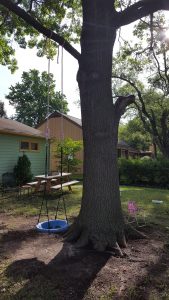
Dan: This is my kids' swing on the oak tree in my front yard. We used to have the swing on a different branch, but it blew off in a windstorm, and you can now see where that branch broke off (stump on the right, about 10 feet up). I have wondered ever since whether or not our swinging on that branch weakened it and caused it to fall off like that in the storm. Prior to the moment it fell off, it showed no exterior signs of being damaged in any way. People I ask about this seem to fall into two opposing camps, and I've come to think of it as a conversational Rorschach test indicating a predilection for two opposing worldviews: One in which everything that happens to us is basically our own fault, the other that we live in a universe where events occur randomly due to natural forces over which we have no control.
Jake: I don't think your kids' swinging weakened it; if anything a repeated fairly light stress (like wind) would make a branch stronger. The ropes may girdle the branch over time, though, and that could kill a branch -- but you would have seen the leaves and bark falling off long before the branch broke. I guess I hold a third worldview: not your fault, not random. There's a cause, we're just not smart enough to know what it is. My Kansas Bestiary co-author Doug and I had a long Wendell Berry-inspired conversation about this very thing. See the Regal Fritillary essay for more.
Dan: Reminds me of my favorite line from one of my favorite books (which also happens to be about trees), Italo Calvino's The Baron in the Trees, about a little boy who stomps away from a family dinner in a huff, climbs a tree in a nearby forest, and ranges across Europe for the rest of his life, tree to tree, never returning to ground: "I, too, have lived many years for ideals which I would never be able to explain to myself; but I do something entirely good. I live on trees."
-Jake Vail is an Information Services Assistant, and Dan Coleman is a Collection Development Librarian at Lawrence Public Library.


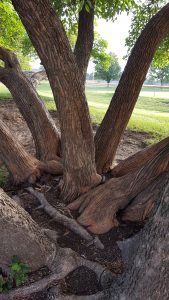
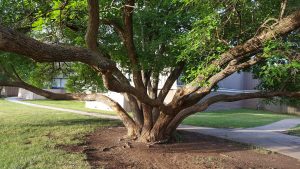
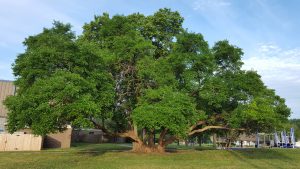
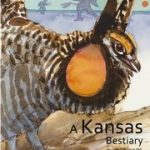

Add a comment to: Interesting Trees